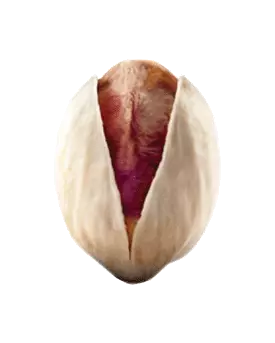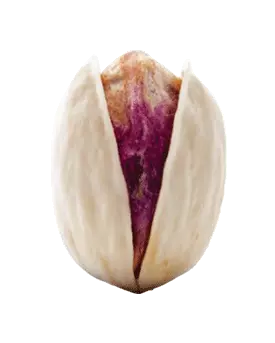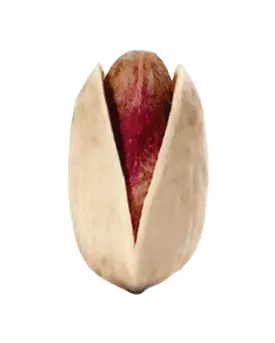Iranian pistachios are popular for their meaty texture and richer nutty taste. If you lived 40 to 50 years ago, you would see ”the red-dyed” Persian smiling pistachios that swept the US market during the 1970s. American importers felt that dyeing the nuts would make them more attractive and in turn, would boost sales.
Iranian pistachios are no longer dyed red, but the fact remains that they are still the top choice in the market. They are available in-shell, shelled, or as other pistachio ingredients . The in-shell pistachios are divided into three main groups of round, long and jumbo. Shelled pistachios are called kernels. They include regular kernels and green kernels. This article discusses in-shell pistachios produced in Iran and slightly mentions pistachio kernels and other ingredients obtained from these pistachios.
Why Are Iranian Pistachios Better?
The quality of Iranian pistachios is because of several regional and biological factors. Regional factors are fertile soil, suitable climate, average cold and rainy winters, sunny spring, and summer days. Long sunny days of spring and summer give the kernels ample time to assimilate as many nutrients from the leaves and soil as possible.
For biological factors, Iranian pistachios have more unsaturated fats (known as healthy fats). More unsaturated fats make these pistachios tasty and healthy. It also increases their ability to be roasted at higher temperatures (roastability). Higher temperatures release the taste and smell of pistachios. And to some degrees, it kills harmful fungi and bacteria existent on the nuts.
Iranian pistachios produce more ingredients than any other types. More than 20 types of pistachio ingredients are currently shipped from Iran and are available on the market.
Iranian suppliers have access to a rich natural reservoir of pistachios. This enables them to find pistachios with the most suitable flavors and textures for almost any purpose. For example, ice creams taste better with more crunchy pistachios. And gourmet foods need a type of pistachio with a soft texture. You need a pistachio type with more fat content to make oily pistachio paste.
Variety of Iranian Pistachios
During the past 100 years, a new variety was developed and became beneficial in several aspects every decade or two. Curious Iranian farmers would try it by cultivating it on a tiny scale. If it survived enough to become permanent and commercially stable, other farmers would become tempted to use it.
The natural diversity of Iranian pistachios probably equals the number of regions growing pistachios, which adds up to 90 as of 2022. Each pistachio type has a local name that also signifies the quality or shape of that pistachio. This rich nature-driven diversity is one of the main reasons Iranian pistachios have stood the test of time.
All qualities considered, Iranian in-shell pistachios are divided into three main groups:
 Round pistachios:
Round pistachios:
A pistachio type is considered round if the ratio of length to the largest diameter is less than 1.5. E.g., “Fandoghi Pistachio” (accounting for 40% of pistachio orchards)
 Long Pistachios:
Long Pistachios:
In this type of pistachio, the ratio of the length to the largest diameter is more than 1.5. E.g., “Ahmad-Aghaie” (accounting for 12% of cultivation ), and “Akbari Pistachio” (accounting for 15% cultivation)
 Jumbo Pistachios:
Jumbo Pistachios:
This type of pistachio is round but has bigger dimensions. E.g., “Kalleh-Ghouchi” (accounting for 20% of cultivation).
Classification of Iranian Pistachios
The second type of classification divides Iranian pistachios into Open and Closed-mouth. Open-mouth pistachios split when ripened. Closed-mouth pistachios don’t split at the suture when ripened. So they have to be cracked mechanically.
Naturally open (NO) pistachios are called “smiling nuts”. They are sold in bulk or retail amounts. Mechanically open (MO) pistachios are mainly used to produce kernels (nutmeats).
All types are available as roasted, salted, and roasted with added lime.

Fandoghi Pistachio
(Round Pistachio)
Fandoghi (round pistachio) is the most widely known and the most nationally cultivated pistachio in the country. It accounts for 74% of the production in Kerman, where the majority of Iranian pistachio is produced.
This nut has the lowest body shape index compared to other pistachio types and resembles a hazel shape (Fandoghi means “hazel-like” in Farsi).
Available Size (pcs/oz): 28-30, 30-32, 32-34.

Kalleh Ghouchi Pistachio
(Jumbo Pistachio)
🟢 Kalleh Ghouchi is also a round, delicious, tasty, high-fat pistachio. It is larger than Fandoghi pistachio.
🟢 Kalleh Ghouchi pistachio has the largest body shape index. opposed to Fandoghi pistachio with the smallest body shape index across all pistachio types. istachio with the smallest body shape index across all pistachio types.
Another way to distinguish Kalleh Ghouchi from Fandoghi pistachio is by comparing their shell color. Fandoghi pistachio has a cream shell. Kalleh Ghochi Pistachio has an off-white to light-brown color.
🟢 Perhaps the most noticeable difference between Kelleh Ghochi and Fandoghi pistachio is its “berry count”. This is the number of pistachio nuts in an “ounce” (28 grams). There are between 20 to 26 pistachio nuts in an ounce of Kalleh Ghouchi. There are 28 to 34 Fandoghi pistachios.
🟢Kalleh Ghouchi (Jumbo) pistachio nut has a rich history in cultivation. It has been cultivated for more than 4000 years. Its present superior position in the market is the outcome of the Iranian farmer’s perfect ability to refine pistachio cultivars.
🟢 The name “Kalleh Ghouchi” in Persian means “like a rams’ head” which refers to the shape of the pistachio.
🟢 Available Size (pcs/oz): 20-22, 22-24, 24-26

Ahmad-Aghaie Pistachio
(Long Pistachio)
🟢 Ahmad-Aghaie pistachio is probably the most liked and the fastest-growing pistachio type in the country. The cultivar was found and refined by a farmer of the same name. Despite being introduced only recently, its cultivation is growing rapidly.
🟢 The Ahmad-Aghaie pistachio needs a shorter time to reach the production stage and it produces a high yield.
🟢 Ahmad-Aghaie pistachio has a red, hefty kernel in a white-cream shell. This has resulted in its profitability and marketability.
🟢 Available Size (pcs/oz): 22-24, 24-26, 26-28, 28-30

Akbari Pistachio
(Super Long Pistachio)
🟢 Iranian Pistachio Akbari boasts the highest economic value as it has the largest kernel to shell ratio (approximately, 49% to 50%). The nut is super long and the kernel is very visible.
🟢 Akbari pistachio is a relatively new nut. It was introduced by a Kermani farmer of the same name during the 1950s. Its cultivation and popularity have grown since.
🟢 It is an early ripening crop with the new harvest hitting the market in late September.
🟢 Available Size (pcs/oz): 18-20, 20-22, 22-24
Benefits of Iranian Pistachios to Suppliers and Consumers
Iranian pistachios are famous worldwide for being delicious and tasty. And they have truly lived up to the expectation. They are likable by both suppliers and consumers. Here, we explain some of the physical and chemical characteristics of Iranian pistachios that have made them famous.
Reasonable Kernel to In-Shell Ratio
You get more value for your money when you buy Iranian pistachios. They have a high meat-to-shell ratio. It means you get more edible meat (kernels) for your money.
The whole single jumbo pistachio, shell and all, weighs up to 0.02 ounces (around 1.07 grams). The nutmeat (the piece of the pistachio that you eat) makes up about 48 percent to 50 percent of that weight.
Taste and Safety
Iranian pistachios have a world-famous flavor for having rich contents of unsaturated oil. Their flavor can be improved by roasting at higher temperatures for at least 20 minutes.
The following list indicates the five notable factors that make these types of pistachios tasty:
- They have had thousands of years to reproduce and diversify in the country.
- Unique electromagnetic frequencies in the region affect the pistachios differently.
- The soil is more fertile, which can affect the texture, taste, and quality of pistachio nuts.
- The weather conditions and other factors affect the taste and quality of Iranian pistachios.
- No pesticides, GMOs, or artificial chemicals are used in their production, making them as natural as possible.
Roastability
Roasting is described as cooking a food item over dry heat, which would cook the food equally on all sides. Pistachios are often roasted in-shell. Iranian pistachios have higher unsaturated oil content. So they are more suitable for roasting at high temperatures (160 to 180°C) than American or Turkish pistachios. Pistachios are generally roasted to improve their aroma, taste, and crunchy texture. Roasting also destroys live bacteria or fungi.
Some pistachio suppliers suggest lower roasting temperatures. But they will not enhance the taste or kill bacteria. During roasting, nuts lose some of their moisture. That describes why the fat content per ounce is somewhat higher in roasted nuts. A roasted nut weighs lighter than its raw form.
Integrity and Texture of the Kernel
Perhaps, the most attractive feature of Iranian pistachios for suppliers is the integrity of the kernel. The kernel does not come off during packing, shipment, or storage. Iranian kernels hardly ever fall apart into pieces after packaging, regardless of the type. They also have a tenable texture because of their rich contents of unsaturated fatty acids. So the kernel does not become loose in the shell (shelling stock).
Marketability
The famous adage “a good product sells itself” is true for Iranian pistachios. The net profit margin is more significant with these pistachios. Companies can pass some of the savings to consumers. They can be sold at higher prices. And they reduce the need for advertisement. You can find useful market ideas for green pistachio kernels in another article.
Versatility
This attribute refers to the ability of a food ingredient to be used for a variety of purposes. Versatility of Iranian pistachios increases with their derivatives. As mentioned before, more than 20 direct products are produced from pistachio kernels. These include pistachio paste, granules, powder, splits, flakes compounded by different treatments such as roasting, salt treatment, and flavoring. There is almost one product for every purpose or preference. No other pistachio supplier can diver that type of diversity and richness.
conclusion
If you have never tasted Iranian pistachios, we recommend you do so. They provide almost all the essential nutrients your body needs every day.
This post was written to give you the necessary information about Iranian pistachios. Feel free to leave your comments in the comment section. The number of varieties and ingredients of these pistachios increases on a daily basis. So, stay tuned to our website for more information.
In the meantime, don’t forget to share this post with your colleagues and friends.
FAQ



Dear Sirs,
Salaam – Please let me know availability of newcrop Iranian Pistachios will start from when ? We required kernels in 10kgs shrink-wrapped packing and wonder whether you can export the same from Iran. Will be waiting for your reply with details of availability inorder to take this matter further ahead.
Thanks & Regards
JAYESH SHAH
Hi how are you
Am Mrs. Piyarat roopnagam
Manager of samin goldstar artist sani parsa
( Thailand) CO.,LTD.
Am interested of pistachio for export
Can you give me more details.
HI I AM VANSH JAIN FROM KHARI BAOLI ASIA’S BIGGEST WHOLESALE MARKET I WANT KNOW ABOUT PISTA AND THEIR RATES TO NAVA SHEVA INDIA
I WANT ALL QUALITY RATES OF 1 CONTAINER TO INDIA
Hello Vansh Jain,
Please go to Contact Us and fill out a form. My colleague will send you all the details.
Thanks